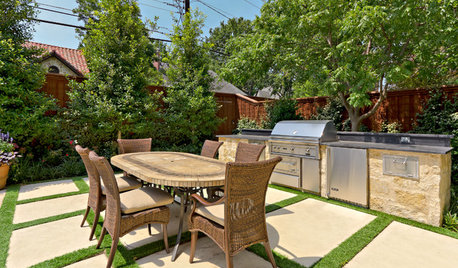How many people do you feed from your garden?
trsinc
16 years ago
Related Stories

HOME TECHTo Feed and Protect: Care for Your Pet From Afar With New Devices
You might miss the nuzzles, but your dog or cat won't miss food, water or monitoring with these high-tech feeders and cameras
Full Story
GARDENING GUIDES8 Native Shrubs for Year-Round Bird Feeding
It’s not just about berries. These plants provide insects for birds and seasonal interest for gardeners
Full Story
SMALL HOMES16 Smart Ideas for Small Homes From People Who’ve Been There
Got less than 1,000 square feet to work with? These design-savvy homeowners have ideas for you
Full Story
CONTAINER GARDENSHappy Houseplants, Happy People
Potted plants add life and beauty to a room. Learn easy ways to keep them healthy
Full Story
GARDENING FOR BIRDSFeed the Birds: 6 Plants for Abundant Winter Berries
Be kind to your fair feathered friends during lean food times by planting a shrub or tree loaded with nutritious snacks
Full Story
FLOWERS AND PLANTSPlant Ilex Cassine for a Privacy Screen That Feeds the Birds
Dahoon and its hybrids provide lovely evergreen foliage in southeastern U.S. gardens
Full Story
GARDENING GUIDES15 Native Flowers That Feed Native Bees
These perennials offer superfood to hundreds of bees and are gorgeous in their own right
Full Story
MOST POPULARThe Perfect Houseplant for People Who Kill Houseplants
If you can fill a jar with water, you can keep golden pothos vine happy — and it will pay you back with cleaner air and a greener home
Full Story
HOUSEKEEPINGCan-Do Cleaning Strategies for Busy People
While you dream of having a maid (to go with the cook and chauffer), this simplified cleaning routine can keep your real-world home tidy
Full Story
INSPIRING GARDENSWhat We Can Learn From Longwood Gardens’ New Meadow
Sustainability, ecology, native plant communities ... this public garden is brimming with lessons on horticulture for home gardeners
Full StoryMore Discussions






marshallz10
sinfonian
Related Professionals
Belmont Landscape Architects & Landscape Designers · Benbrook Landscape Architects & Landscape Designers · Kyle Landscape Architects & Landscape Designers · Parole Landscape Architects & Landscape Designers · Bell Gardens Landscape Contractors · Bristol Landscape Contractors · Elkridge Landscape Contractors · Federal Way Landscape Contractors · Gainesville Landscape Contractors · Middleton Landscape Contractors · Painesville Landscape Contractors · Rockwall Landscape Contractors · Rosemount Landscape Contractors · Wilton Landscape Contractors · Campbell Driveway Installation & Maintenanceweirdtrev
Beeone
paulc_gardener
bejay9_10
marshallz10
skagit_goat_man_
opal52
catherine_nm
digit
granite
trsincOriginal Author
nygardener
weirdtrev
burntplants
pnbrown
skagit_goat_man_
suzannesks
zeedman Zone 5 Wisconsin
belindach
ruthieg__tx
trsincOriginal Author
belindach
hamiltongardener
crabjoe
pnbrown
yaquigrande
trsincOriginal Author
carlsbadgardener